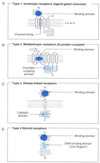Mechanisms of Drug Action Flashcards
(26 cards)
What are the four types of drug antagonism?
1) Receptor blockade
2) Physiological antagonism
3) Chemical antagonism
4) Pharmacokinetic antagonism
What is Receptor blockade?
An antagonist binding to a receptor to prevent binding of the agonist.
What is ‘Use Dependency’?
Use the example of Local Anaesthetics
The more active the tissue, the more effective the ion channel blocker.
E.g.: Sensory neurones fire infrequently unlike nociceptor neurones, so LAs will have a selection towards the more ‘used’ nociceptors
What is Physiological Antagonism?
Give an example (NA Vasoconstriction)
When two drugs counteract each others effects.
NA on the vasculature binds to adrenoreceptors and causes vasoconstriction. If we coadminister histamine - it acts on different receptors and causes vasodilation.
What is Chemical Antagonism?
A chemical interaction of drugs in the system
What method of action does Dimercaprol have and what does it do?
Dimercaprol is a chelating agent - it forms heavy metal complexes which are more rapidly excreted by the kidneys. This is useful for things like lead poisoning.
What is Pharmacokinetic antagonism, and what are the three ways it may work?
When one drug reduces the concentration of the other drug at the site of its action.
A drug may reduce the absorption, increase the metabolism or increase the excretion of another drug
What is the clinical relevance of Pharmacokinetic antagonism?
(Use barbiturates as an example)
Must be aware of this when coadministering drugs to make sure they don’t interfere with each other.
Barbiturates increase the production of microsomal enzymes, so if another drug is given that is metabolised by those enzymes, its effect will be reduced.
What is Drug tolerance?
A gradual decrease in responsiveness to a drug with repeated administration.
What are the five causes of drug tolerance?
- Pharmacokinetic Factors
- Loss of Receptors
- Change in Receptors Exhaustion of Mediator Stores Physiological Adaptation
What are the pharmacokinetic causes of drug tolerance?
The drugs metabolism increases when it is repeatedly given.
e.g. Alcohol and Barbiturates
How are receptors lost upon frequent use of a drug?
A cell takes off its receptors via membrane endocytosis
How does loss of receptors increase drug tolerance?
During receptor down-regulation, there are fewer target sites for the drug, so its effects are reduced.
How does a change in receptors cause drug tolerance?
Receptors undergo a conformational change under continued stimulation
The proportion of effective receptors decreases
What is the exhaustion of mediator stores?
If a drug exerts its effect via the use of a mediator produced by the body e.g. noradrenaline, then the bodies store of this will be used up, so on repeated administration, the drug will have a reduced effect.
Describe the change in tolerance of Amphetamines upon repeated administration:
Tolerance increases; exhaustion of mediator stores.
Amphetamines bind to Uptake-1 protein and gets taken into the central noradrenaline synthesis system, it replaces the noradrenaline in the vesicles and you get a big increase in the production of noradrenaline.
This uses up stores of NA, so next time you won’t get so great a response.
What is physiological adaptation?
Like a homeostatic response to a drug; the body attempts to maintain a stable environment in response to the drug, increasing its tolerance
What are the four receptor families?
Type 1 - Ionotropic
Type 2 - G-protein coupled
Type 3 - Tyrosine kinase-linked
Type 4 - Intracellular steroid type
What are type 1 receptors?
How do they work?
How fast are they?
Ion channel linked receptors (ionotropic)
Very very fast (milliseconds)
Give two examples of Ionotropic receptors:
Nicotinic Acetylcholine receptors
GABA
What are type 2 receptors?
How do they work?
How fast are they?
G-protein coupled
Receptor links to a G-protein before a response is initiated
Seconds (slow)
Give an example of G-protein coupled receptors:
Beta-1 adrenoceptors in the heart
What are type 3 receptors?
How do they work? (hint: it’s in the name)
How fast are they?
Tyrosine Kinase-linked receptors
They result in phosphorylation of intracellular proteins
Very slow; minutes
Give two examples of Tyrosine Kinase-linked receptors:
Insulin receptor
Growth factor receptor



